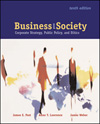 |  Business and Society: Corporate Strategy, Public Policy, Ethics, 10/e James Post,
Boston University
Anne T Lawrence,
San Jose State University
James Weber,
Duquesne University
Managing a Diverse Workforce
Chapter ObjectivesThe workforce in the United States is more diverse than it has ever been, reflecting the entry of women into the workforce, immigration from other countries, the aging of the population, and shifting patterns of work and retirement. Equal opportunity laws and changing societal expectations have challenged corporations to manage workforce diversity effectively. Full workplace parity for women and persons of color has not yet been reached. However, businesses have made great strides in reforming policies and practices in order to draw on the skills and contributions of their increasingly varied employees. This chapter focuses on these key questions and objectives:
1Who are employees today in the United States? In what ways is the workforce diverse, and how can it be expected to change over time? |
 |  |  | 2Where do women and persons of color work, and what are they paid? What roles do they play as managers and business owners? |
 |  |  | 3What role does the government play in securing equal employment opportunity for historically disadvantaged groups? Is affirmative action an effective strategy for promoting equal opportunity, or not? |
 |  |  | 4In what ways does diversity confer a competitive advantage? |
 |  |  | 5How can companies best manage workforce diversity, making the workplace welcoming, fair, and accommodating to all employees? |
 |  |  | 6What policies and practices are most effective in helping today's employees manage the complex, multiple demands of work and family obligations? |
|




 2002 McGraw-Hill Higher Education
2002 McGraw-Hill Higher Education